Many of us are well aware of Alex’s expertise when it comes to giving sound and thorough advice pertaining to the selection of the right tool or stone. Over the last few years, Alex has increased her role with respect to teaching about the proper use of tools. This interview will now showcase her considerable talent and training as a sculptor.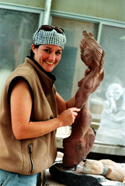
LE: Who are you?
AM: Certain species of ravens are known to make their own tools... CAW, CAW, CAW. Who am I? That’s a big question, and sometimes I have to check to see which hat I’m wearing before I answer. I am a Southern California sculptor who is rarely in Southern California. More seriously, I am a professional sculptor that works predominantly in stone. The other hat that so many NWSSA members see me in, is as the “The Tool Goddess”. (I’m sure there have been other names, but I’ll stick to that one). I now work with Trow and Holden as their Field Representative, but prior to that I owned my own business, “Pronto Tools for Sculpture”.
LE: How does your life history relate to you being an artist?
AM: I came from a very creative family. My father is a professional musician and composer of extraordinary capabilities, and my mother was a painter in her earlier years. When my sister and I were children, she was very supportive for us, encouraging drawing, painting, and in my case, collecting rocks and cool shaped stuff (including bell peppers at the supermarket). I feel very lucky that I was able to choose art as my path at a young age and be encouraged all the way along. Even when I ventured into the tool business, I think my parents were more in support of me focusing on my own sculpture.
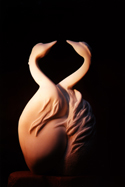
LE: Why did you become an artist?
AM: I didn’t know I had a choice! I really feel that way. My lifestyle and makeup is inherently creative. I am a stone carver, now, maybe always, but really it wouldn’t matter- the choice of living creatively is what is important to me. By choosing to be an artist I can speak in a visual tongue that can pass from my spirit, through my mind and hands, and be passed into a material that speaks on its own, without need for me to be there to translate. We no longer need to be present, physically for our intentions to be transferred to others - they become the viewer’s.
LE: Tell us a little bit about your educational background.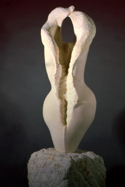
AM: I started studying figure drawing at the community college, with a wonderful man who challenged young art students to “think outside of the box” and gave us assignments such as “draw the sound of the chickens down in the barn.” What it did was help us understand that the figures we were drawing were alive and had a voice and a soul, and that it is our job as artists to reveal that. At that time, the only place I was happy was when I was in art classes. I transferred to the State University at Northridge in California, and was blessed by two extraordinary professors who really helped me see “ME”, and how to incorporate that into my work. I studied painting and drawing exclusively for nearly four years before I ever stepped into a sculpture lab. It was while I was studying abroad in London when I found all the figure drawing classes were filled, and I had nowhere to do art. I was a little intimidated to take a sculpture class, as I thought one needed to know how first, but it was the most natural thing in the world for me. After that, I could never get dirty enough doing anything else! I returned to the states and took sculpture four days a week, and continued with drawing as well as a lot of art history. I was wise enough to stay at the University for as long as I could justify, as they had a bronze foundry, carving area, wood, and ceramics... it was really limitless - a fantastic opportunity. I graduated with a BA with an emphasis in sculpture, in 1992.
LE: Who or what have been the major influences on your artistic life?
AM: My mentor and college professor, David Elder, and his wife, Linda, who is also a sculptor, were probably the greatest influences on my choice to make sculpture my predominant path. Dave was one of the first, outside of family, who treated me with a respect that said, “Why not?” Whatever it was, power tools, stone, resin, bronze, if I could imagine it, he gave me the feeling I could do it and figure out how. They both live the creative life that I admire and strive for.
More specifically, on my first trip to Italy had a powerful influence. I was taking a clay-modeling course, and was visiting Rome. Every morning I went to see Bernini’s “Ecstasy of St. Teresa”. I was traveling alone, and I figured if that did not protect me, nothing would! But each day, for five days, I sat and looked at that sculpture for a long while and just looked in awe. The breath that you could almost feel pass from her lips overwhelmed me. I said, “That’s what I want to do”. I’m no Bernini, but he was a pretty crazy guy, and anyway... I’m a Morosco!
In 1993, I went to Art City to get some help basing a piece. I didn’t leave for five years. The place captured me, and I was on a real learning journey of stone. I quickly found myself the business and studio manager, which included overseeing the gallery, which then staged about eight shows a year. I look at that period as an intense post-graduate experience without the paper degree. Since then, there have been several “sabbaticals” including travel and exploring other places to work and live, but I’ve kept my studio there due to the great wealth of stone and the hub of carvers. I learned a great deal about stone, its make up, how to move it, and how it moves us.
LE: How does your art reflect your philosophy?
AM: When I think of my most personal work, and reflect on what it says, and how that is related to my own values and philosophies, I think it’s a pretty raw and emotional place. Sometimes that is not even in a stone piece, but an artful expression. Using what is immediately around me is inspiring. To create a weave of feathers, shells, and my own cut off hair, is a totemic experience that is as creative – or more so – as a 12-foot monumental piece of sculpture. There is preciousness in the simple things that often get overlooked in our overly impacted and busy lives. In the last three months, since I closed my business, I have really been able to feel a lot more, and create art every day. That is sacred stuff, and an imperative outflow for me. I am a mere vehicle for some of these thoughts to be shared, maybe I will be able to touch a few lives, and celebrate some of the path. At the end of each day, I try to ask myself if that were my last, would I be all right with that? It’s like taking my own pulse, and checking up on myself.
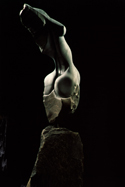
LE: How has NWSSA influenced your work?
AM: The NWSSA has influenced my whole life. I don’t think I can really separate the two (work/life). From the people that I have met, to the territories and the workshops I have given and attended, it has really mapped out a lot of my life. I may add, I go to workshops across the country, and I feel the Northwesterners are the most supportive group to one another on a lot of levels. I don’t know if it’s all the wet and cold that makes for such warm people inside, but I know it’s good. I am seriously considering a move up in the Seattle area, but that will be revealed over time. I have a really great setup down south, that I have worked hard for and finally have it flowing well - compressors, air lines, drop downs and a handy forklift at my disposal are hard to just up and leave. I can accommodate several carvers at once, allowing for a good place for teaching, which I do on a regular basis. Living steps from the beach isn’t all bad either. I am on the road so much of the summer, it would be a shame to move to Washington to live here from October to April!
LE: How would you characterize your art?
AM: The human figure, mostly female, seems to be the predominant thread in my weave. I look at my pile of rocks, and think, “How am I ever going to liberate all these gals out of those rocks?” I never tire of the possibilities that working with the figure offer. The use of polished, textured, and raw natural stone incorporated through the figurative composition is continually interesting to me. Some of them are not figures per se; they are beans, or seedpods. Lots of beans. Beans, shells, Georgia O’Keefe, and me. It’s flattering to hear people make that correlation. O’Keefe is an inspiring woman to me all around, from her work to her choices that built her life and she had black chows too, that was a great surprise!
LE: What are your sources of inspiration?
AM: I am inspired by the simplest things - again, a shell, a bell pepper, a shape in nature. The figures are usually already there, they just need that extra rock taken off them! Most of my stonework is direct carving. I will use calipers, measuring, graphs and grids, but mostly I jump in and take the direct approach. Sometimes I make a commitment to a carve that I would have avoided if I used a more methodical pointing system, but that is not what most of my work is about. After all, I think cameras are great tools too!! I enjoy more freedom in carving. I figure it’s hard enough, and should still be fun. Too much math hurts!
I am also much inspired by language and symbolism. I am starting on the “thought workings” of a piece called, “The Bread, the Blood and the Bones”. I’ve been chewing on ideas for it for a year, re-worked a poem again, and now I’m excited to go on it. I’m thinking of incorporating limestone, pipestone and bronze, a large outdoor piece.
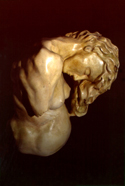
More tangible, the last few months have been filled with “Mother and Child”- three versions. One was a commission, and the other two are personal (meaning for sale/inventory). A big range in scale, the largest being a 4’ x 3’ x 3’ block of Italian Verona marble, and the smallest was an Italian alabaster, miniature, about 10” across. I am also finishing a piece out of Arizona catlinite (pipestone) which has been a furor of detail, including feathers, and an afro on an African-looking winged goddess with humanly impossible proportions that I think give her some real spunky movement.
I have started to incorporate a lot more detail in my work. I think this reflects my personal demand to SLOW DOWN, and really value what I am participating in. Of course this does not get 30 new pieces out working for me... It tends to keep me working on one commission at a time, but I’m booked in that regard, so that’s good!
LE: Could you talk more about your commissions?
AM: A few things fell into place for me over the past 6-8 years, and most of that falls under being receptive to a given opportunity. As a figurative-based sculptor, I feel my endeavors are in a way timeless, as they speak of the human experience and become storytellers of our day, as well as those of the past. Religious and/or spiritual art has always been a big slice of the art that comes out of a given society. I was awarded a small commission for a processional crucifix back in 1994. Since then, I have done a total of six liturgical commissions ranging from that small 18” bronze crucifix to one 12’ tall. I was always very happy to receive these commissions, as it is a way I can work with the figure, with great purpose. These are sacred stories in the houses where they live, so I am honored to be the hands they are passed through. These have also been the most challenging. The contract agreements, insurance issues, and committee processes are part of the playing field and are not an optional experience, but inherent in larger scale, or public pieces. Sometimes committees aren’t bad. A recent committee member for a church was Felix de Weldon, now in his 90’s, who is most famous for his monumental sculpture in D.C. of the soldiers at Iwo Jima. It was wonderful to meet him and have him at my studio sharing his input.
In a recent discussion at the Whidbey retreat, we talked about the challenge of sticking with a piece, even if you don’t like where it is. When we work under the condition of having to sick with it, we really push ourselves to pull from what is holding us together. I feel perseverance is where the most passion, love, pain, and peace live.
I have been asked how someone so young and seemingly light spirited could know so much pain, as I rendered in the face of the Padre Serra Crucifix. It was simply what I had to do; I had to walk and sleep in the pain I was trying to convey, and relay a story in an image to those who celebrate that story. I had to reach and think the thoughts, “No matter what you do to me, I will still love and teach love”. Would I accept a commission of a huge, fat, happy, smiling Buddha? ABSOLUTELY!
LE: What work schedule do you keep?
AM: Primarily I work full-time as a sculptor. I’m pretty sure that means 20% carving and 80% promotion, marketing, and running around! I know that when I get to the studio early at 7 am, nothing can pull me out. When I’m doing other work, like promotional and office work, hours fly by, and I’m always amazed at how much of that it takes to really keep the sculpture going. I do also work with Trow and Holden Co. as a consultant throughout the year, with most of that time during summer workshops. When I closed Pronto as a retail business, I knew there was a huge gap that needed to be taken care of, primarily at the stone carving venues. By working with Trow and Holden I can still bring my knowledge and tools to the workshops and help carvers through the labyrinth of tool options.
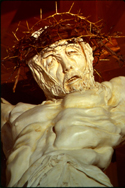
LE: What tools do you use and what stones do you carve?
AM: Anything that gets the job done, and anything that holds still long enough!
Actually I’m a pretty traditional carver. Yes, I use a range of power tools including diamond blades and the rest, but most of my carving is done with Trow and Holden’s range of pneumatic hammers and chisels. On any given piece, I will easily use three different air hammers. I do rough out with a blade, but I really hate dust, and must admit, I am not set up with water cutting tools. I get so much work done with my pneumatic hammers, right down to detail, that I often jump to hand finish work from there. My single carbide point and 2-1/2# hammer are truly my favorite stage of carving. I find that if I carve with a range of tools my image is what my mind sees, not where a tool can fit. I know I’m in trouble when every part of a piece starts to look like the negative space a given tool left behind. I find that especially true with a diamond blade or abrasive pad in the hands of new carvers. They are so turned on by how fast the stone goes away that you could title the piece “Zec at 10,000 RPM”. Also, from a physical perspective, it’s very important to jump around, using different tools. By changing the tools you are using, you will extend your working time on a long- and short-term basis.
Regarding stone - predominantly marble, alabaster, and limestone.
LE: Would you discuss a few of the highlights of your artistic life?
AM: This dovetails directly into that same Padre Serra project. It was epic to get it completed and installed, as they all seem to be. During the unveiling of the piece, which was draped in 26 yards of purple silk, there was a hush that filled the 2000 person audience when the silk was pulled down. When they asked me to come up to say a word, the hush turned into a murmur of, “It’s a woman!” or “She’s so young.” It felt like I was part of a swing in history because, not only in the world of the Catholic Church, but nearly equally in the Art World, this was a piece which was created by a woman. I laughed at the thought that most people probably thought I was just up there to “pull the strings at the unveiling” like Vanna White or something. It was awesome to share a little of my journey with that audience, and stand for all women as I spoke with passion.
More personally, when I had a show in 1999 with a figurative painter, Nicole Duet, I had a sort of “personal unveiling” for my father who had not yet seen most of the 13 works. He immediately left the room and went for his “voice”. He is a jazz and classical saxophonist, and proceeded to play a spontaneous melody to each piece of art. I was so touched by his spontaneity and understood that at that moment, it was the only way he knew how to say, “great job”. Sometimes words just are not enough, and our art is our only voice. He proceeded to compose and publish the 14 or so duets, and each one was inspired and titled after a sculpture or painting. I love how every creative action inspires another- on all fronts.
LE: What are you looking forward to?
AM: Continued time in the studio! I feel like I’m on holiday, even though I am still working most every day, in studio or out. Commission-wise, I am working on several private and larger scale public pieces. I am currently working on various proposals to several churches, for figurative pieces of various themes; some of these can be a year away, so I have to keep focused on always bidding on new work.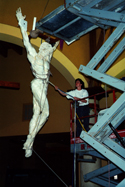
And, I am looking forward to a very busy summer. I will be at workshops for the better part of July through September. I am most looking forward to Camp Brotherhood this year, as the figurative tract that Sabah, myself, Michael Naranjo, and Alfonso will be teaching is really compelling me to bring my best to the carvers as an instructor.
LE: You started this interview with “CAW, CAW, CAW”. What roles do crows and ravens play in your life?
AM: Corvi? I have lots of inspirations and future ideas, but have only done one with an actual Corvi involved - “Nursing the Raven” in British Colombian chlorite. I have long chosen the Raven as one of my guides, and this piece is about taking care of the self. Nurturing the soft animal within, while leaving an open hand so she can always fly and feel the wind. Chlorite is a wonderful, fun stone to carve, and most detail was achieved with the Bantam air hammer and with wood tools adapted to fit. Heat-treating the sculpture and Kiwi clear boot polish is the ancient secret to this amazing polish - oh, and up to 1200 grit hand-sanding! I also pulled a mold from this piece, for an edition in bronze.
AM: Finally, I just want to say...
I feel that the educational venues of the workshops are a very crucial part of our industry. Universities and schools that have a serious stone carving department are few and far between, and most people carving are not really tied into any formal “guild”. We have little to no apprenticeship programs in this country, which leaves a huge gap in the passing down of skill and knowledge. I would like to see more of that, and groups like the NWSSA seem to be the way stone carvers can join resources, continue their own learning, and share with new carvers. I fear a big generation gap is coming, because we don’t see many young college age people doing much carving. I think a younger crop of carvers is necessary to keep it a live and growing venue 20-30 years from now.
Overall, I feel really blessed that someone handed me a rock one time in college, and I gave it a try. In regards to sculpture in general, when compared to other venues such as painting, I just could never get dirty enough, go deep enough, or feel like it created me more than I created it.
